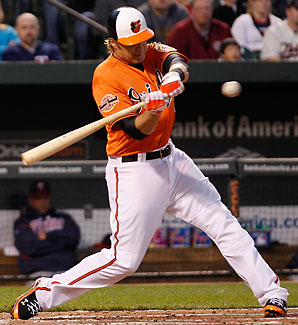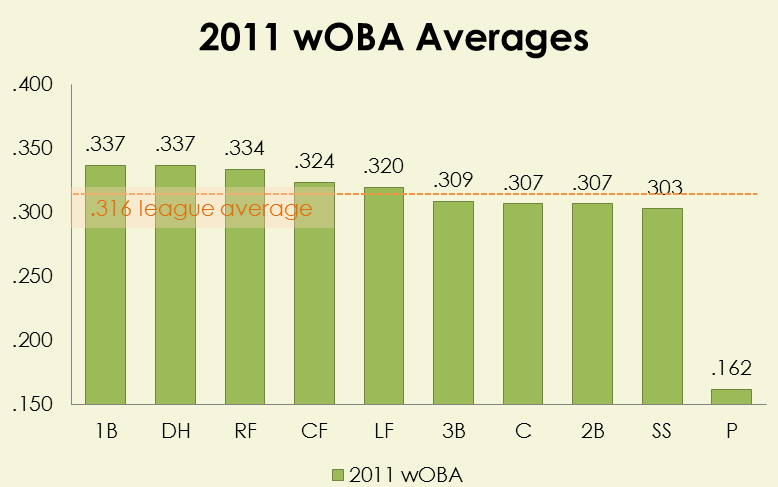 Indians Archive
Indians Archive  View from the Porch: Mark Madness
View from the Porch: Mark Madness
 The 2013 Cleveland Indians are probably going to be near the top of the American League in strikeouts. The free agent acquisition of Mark Reynolds and the trade that brought Drew Stubbs over from the Cincinnati Reds added 175 strikeouts, going off of last year’s numbers, to the lineup, even with the loss of Shin-Soo Choo and his 150 strikeouts. Add in a full season for Lonnie Chisenhall, who strikes out over 20% of the time. The Indians were third in the American League in strikeouts in 2012, whiffing 1,087 times in just over 5,500 at bats.
The 2013 Cleveland Indians are probably going to be near the top of the American League in strikeouts. The free agent acquisition of Mark Reynolds and the trade that brought Drew Stubbs over from the Cincinnati Reds added 175 strikeouts, going off of last year’s numbers, to the lineup, even with the loss of Shin-Soo Choo and his 150 strikeouts. Add in a full season for Lonnie Chisenhall, who strikes out over 20% of the time. The Indians were third in the American League in strikeouts in 2012, whiffing 1,087 times in just over 5,500 at bats.
For this week’s View from the Porch, I’m going to focus on Mark Reynolds. The peanut gallery, who commented on the SportsTime Ohio Facebook feed regarding the official announcement of Reynolds’s signing, had these lovely sentiments to say:
David: “strikeout king with low batting average; A perfect sign for this front office; Not a good move”
Matthew: “Could the Indiams [sic] be the first team to be no hit and all 27 out be strikeouts?”
Brian: “another guy batting .220 way to go! Keep it consistent Tribe”
Jonathan: “Fun Fact: Mark Reynolds is the fastest player in MAJOR LEAGUE HISTORY to strike out 1,000 times. Huzzah Shapiro!”
The intelligence parade continued on the Indians’ official Facebook page:
Zac: “Awful news. Stubbs and Reynolds will lead the team in strikeouts. This is stupid I don't know why I'm still an Indians fan. Mark Shapairo [sic] is the worst GM in all of baseball. We just dumped our best outfielder for a washed out 250 hitter who lead the NL in strikeouts. Who's next, Masterson?!”
Andrew: “The
Ron: “What was his batting average in 2012? In 2011? Please tell me you didn't agree to pay $6 million to the guy who struck out more times in one season than anyone ever. SMH.”
Ryan: “Did we trade the washing machine for him? If so, we got screwed.”
Jason: “Wish I could make $x millions for doing a horrible job like Reynolds.”
Do I begin by pointing out the moron who hasn’t realized that Chris Antonetti has been the GM since the end of the 2010 season? No, wait, I have to start with the people who still think batting average is one of the most important stats in baseball. I didn’t know we had to trade for free agents. Ah, there we go, “for doing a horrible job like Reynolds”. Let that sink in while you read on.
Sabermetricians, or sabrists, whatever they prefer to be called, have often bickered about how much strikeouts matter. Some subscribe to the theory that an out is an out and that striking out helps to stay out of double plays, so, in some instances, a K is more valuable than an out on a ball put in play. Others will argue that not putting a ball in play takes away any chance of advancing runners or the defense committing an error.
One 2009 study from Harvard came to the conclusion that there was a positive correlation between strikeouts and offensive production. The study centered around wOBA, or weighted on-base average, a metric that takes the ways that batters get on base and assigns a value to them based on the average number of runs that specific event leads to in a given season.
I’ll paraphrase from the Fangraphs definition to describe wOBA a little more in depth. Batting average assumes all hits to be worth the same, hence the formula of Hits / At Bats. OPS, on-base percentage plus slugging percentage, assumes that OBP and SLG are each worth the same. According to the link, one point of on-base percentage is actually valued 1.8 points more than one point of slugging percentage. wOBA fills in the shortcomings of batting average, on-base percentage, and slugging percentage.
Calculating wOBA is done by assigning values to each way a player gets on base (walk, hit, hit by pitch) that are called “run values”. For reasons unbeknownst to me, other than that they affect the ability to score runs, stolen bases and caught stealings are also included in the wOBA calculation. The following chart shows the run values from 2012, as calculated by Fangraphs.
|
Result of Plate Appearance |
Run Value |
|
Unintentional Walk (BB) |
0.69 |
|
Hit By Pitch (HBP) |
0.72 |
|
Single (1B) |
0.88 |
|
Double (2B) |
1.26 |
|
Triple (3B) |
1.60 |
|
Home Run (HR) |
2.05 |
|
Stolen Base (SB) |
0.25 |
|
Caught Stealing (CS) |
-0.50 |
By itself, an individual at bat does not take into account the situation. If the batter reaches base via a walk and doesn’t score or a run or drive one in, it still counts towards the batter’s wOBA as 0.69 runs. That walk might extend the inning with two outs and lead to three runs. It still counts as 0.69 runs to that batter. The batter might hit a solo home run. It will count as 2.05 runs when calculating his wOBA. Even if the home run is a grand slam, it will count as 2.05 runs.
In 2012, the wOBA calculation looked like this:
(0.69 x BB + 0.72 x HBP + 0.88 x 1B + 1.26 x 2B + 1.60 x 3B + 2.05 x HR + 0.25 x SB – 0.50 x CS)
--------------------------------------------------------------------------------------------------------------------------------------
Plate Appearances
As you can see, doubles and home runs are worth more runs than singles and walks. Consider hitters who strike out a lot. The trade off is that they hit for more power. Where batting average and on-base percentage make high strikeout hitters look less valuable, wOBA does the opposite.
For 2011, the league average wOBA was .316. For 2012, the league average wOBA was .315. The Fangraphs link above has thisa picture of the average wOBA by position for 2011:

Enter Mark Reynolds. Those who have been against the acquisition, like those MENSA members above, have pointed to low batting average and high strikeouts. In 2011, Mark Reynolds had a wOBA of .350, clearly above the average at his position. In 2012, Reynolds was hurt and never really got on track, posting a wOBA of .335, slightly below the average for his position. Reynolds’s career wOBA is .349, including time at third base, where his offensive production was well above league average, while his defensive prowess negated some of his value. Forty-nine of Reynolds’s 101 hits in 2012 went for extra bases.
By comparison, Casey Kotchman posted a horrendous .271 wOBA, well below league average for first base, which, as the chart shows, is the most productive offensive position. He had 24 extra base hits out of 106 hits.
An offshoot of the wOBA formula is called wRAA, or weighted runs above average. Without getting too technical, as this post has probably been confusing enough, Kotchman was 17.6 runs below average offensively at first base. Reynolds was 8.5 runs above average. So, in upgrading first base this offseason, the Indians added around 25 runs of production to the lineup. It may not sound like much, but it is a major upgrade. It could be an even bigger one if Reynolds returns to his 2011 form, which is right around his career averages. That year, he was worth 16.5 runs above average.
Unrelated to wOBA, according to The Fielding Bible, the leading source of fielding-related statistics, the difference in defensive runs saved between Kotchman and Reynolds is a whopping total of one. That’s right. Kotchman, who was brought in as a supreme fielder and average bat, was negligibly better in the field than Reynolds at first base.
I tend to agree with the side that thinks strikeouts don’t matter a whole lot in the grand scheme of things. As I have delved deeper into sabermetrics and become more of an analytical observer of the game, my views on the game have changed dramatically, and always, in my humble opinion, for the better. Having an understanding of advanced statistics makes it so much easier to understand how the Indians front office operates and why they make some of the decisions that they do. Obviously, as seen from the quotes above, a large number of Indians fans have no desire to look even the slightest bit below the surface. Those are the same people who will say that Mark Reynolds sucked for striking out 200 times and batting .240, even though he hit 30 home runs, was above league average in offensive production, and wasn’t a liability defensively.
I have always subscribed to the theory that you cannot bitch about something unless you try to understand it first. Society doesn’t work that way, and certainly the fans don’t view sports in that way. It’s frustrating to be in the minority of Indians fans and I can only imagine the frustration of the front office. I’ve been in favor signing Reynolds from the time he was non-tendered by
- NBA Announces 2013-2014 Schedule
- Browns Ink Sharknado
- Sharknado A No-Show For Rookie Camp
- Trent Richardson Out Until Training Camp
- Browns Sign Brandon Jackson
- Carrasco Suspended Eight Games
- Browns Add to Wide Receiver Depth with David Nelson
- Browns Need to Learn from Past Draft Mistakes
- Browns Release Chris Gocong and Usama Young
- Browns Missing on Grimes Disappointing, But Not The End
The TCF Forums
- Chris Grant's first 3 drafts
Kingpin74 (Tuesday, January 21 2014 10:13 AM) - The 2014 Offseason Thread
googleeph2 (Tuesday, January 21 2014 9:36 AM) - 2015 Recruiting
furls (Tuesday, January 21 2014 6:57 AM) - Mike Brown
YahooFanChicago (Monday, January 20 2014 11:15 PM) - Movies coming out
HoodooMan (Monday, January 20 2014 9:34 PM) - 2014 Hoops Hockey Hijinx
jpd1224 (Monday, January 20 2014 4:44 PM) - 2014 Recruiting
jclvd_23 (Monday, January 20 2014 2:26 PM) - Wish List - #4 Pick
Hikohadon (Monday, January 20 2014 1:26 PM) - Official- Browns Coach Search/Rumors
OldDawg (Sunday, January 19 2014 6:48 PM) - #1 overall pick Anthony Bennett
TouchEmAllTime (Sunday, January 19 2014 1:28 PM)


